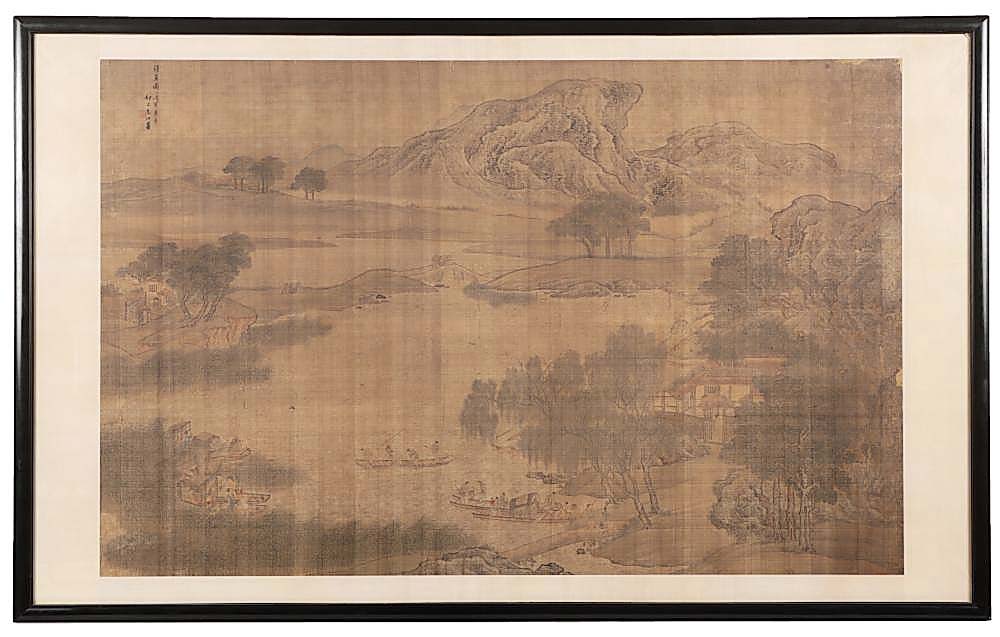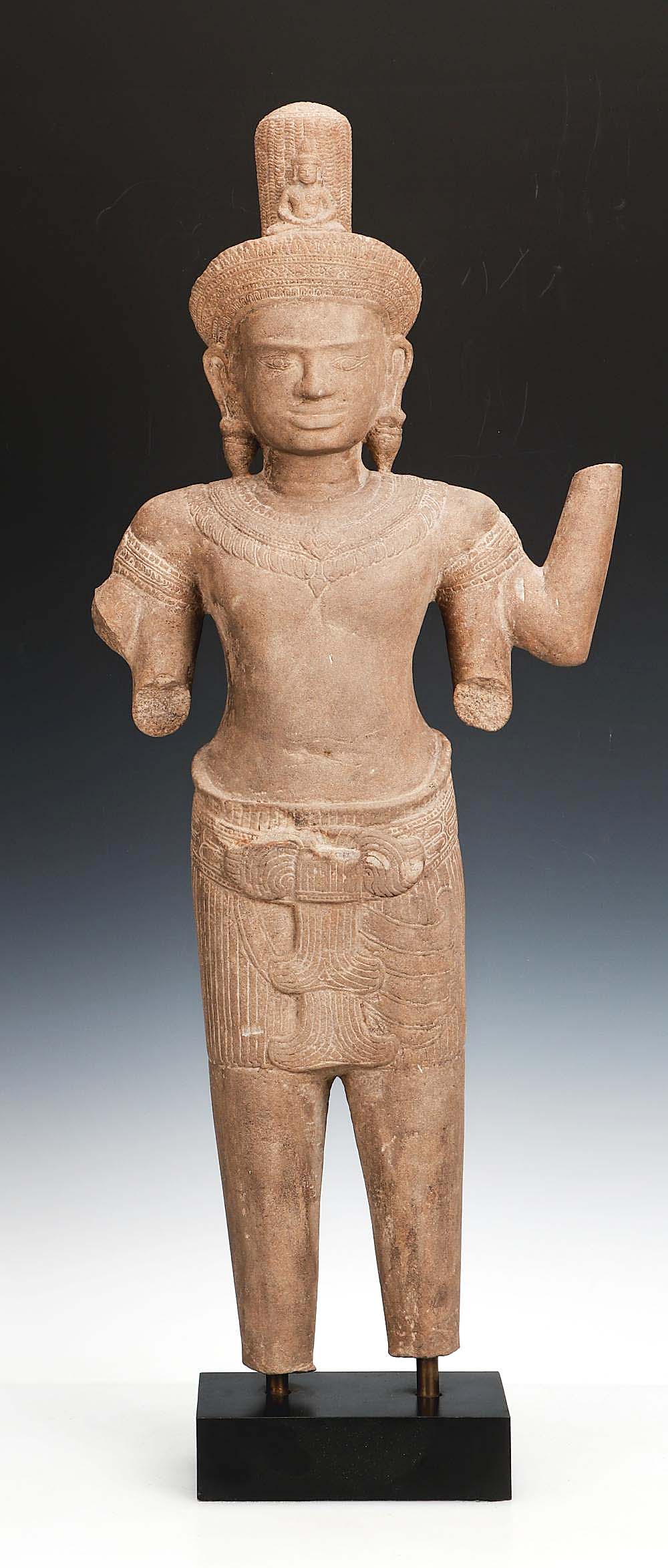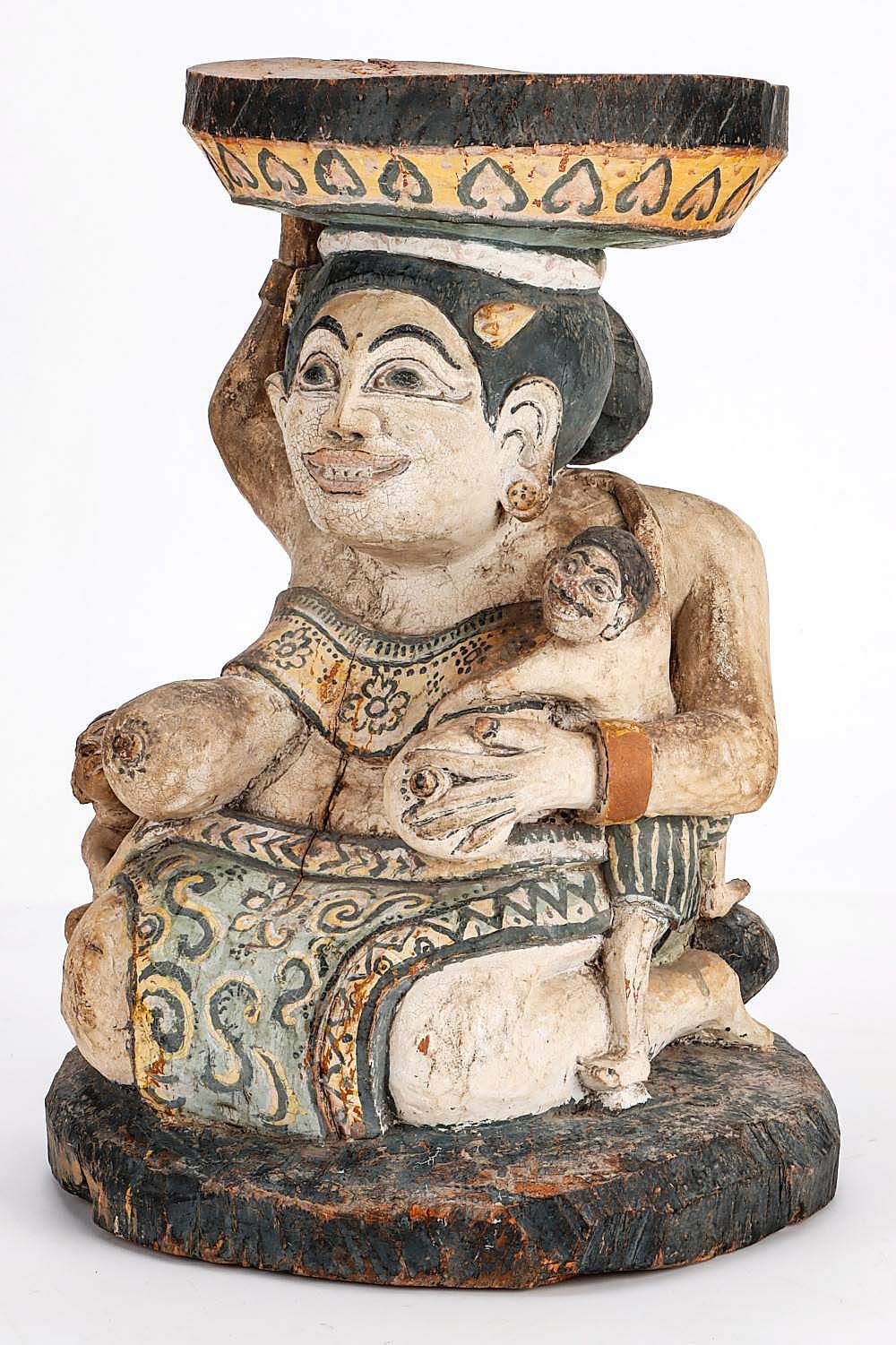
The top lot over the two days was a monumental antique Chinese landscape painting from the late Seventeenth Century. Measuring 52 by 80 inches, it tripled its high estimate, selling at $65,000. “Fishing Scenery,” an ink and color on silk, titled and bearing the signature of Yuan Jiang (1662-1735) and dated 1698 had provenance to the collections of Dr Mattiebelle Stimson Gittinger and Dr J. Price Gittinger.
Review by W.A. Demers
PHILADELPHIA — It was a wrap on Material Culture’s two-day sale on October 29 with ethnographic, tribal, ancient and Asian material commanding bidder attention following October 28’s presentation of the Thomas Wheelock collection of African art. In total, there were 649 lots offered with 565 sold. Leading the results over the two days was a monumental antique Chinese landscape painting from the late Seventeenth Century, which tripled its high estimate to claim $65,000 in the second session. Measuring 52 by 80 inches, “Fishing Scenery,” an ink and color on silk, titled and bearing the signature of Yuan Jiang (1662-1735) and dated 1698, had provenance to the collections of Dr Mattiebelle Stimson Gittinger and Dr J. Price Gittinger. Cataloging surmised that it had probably been purchased in 1961 from Philip Chu, a noted dealer in rugs and curios in Kowloon, Hong Kong.
The Thomas Wheelock Collection of African Art
Thomas Wheelock’s collection was decades in the making, with the sale’s catalog characterizing it as the largest private gathering of Burkina Faso art in the world. Profiled in Christopher Roy’s book Land of the Flying Masks: Art and Culture in Burkina Faso; The Thomas G.B. Wheelock Collection (New York City: Prestel, 2007), its hundreds of notable pieces included works from the Nuna, Bwa, Bobo and Mossi peoples, alongside notable objects from the Lobi, Gurunsi, Winiama and Lela tribes. Rare masks, shrine posts, staffs, figures, scepters, dance costumes, flutes, stools and more were on offer, with the sale comprising 124 lots, all at auction for the first time.
Wheelock was a passionate collector of African art, especially that of Burkina Faso. His aim was to not only celebrate the artistic traditions of the region but to preserve them as well. Rather than merely acquiring the art, he valued the relationships he formed with local artists and communities, often engaging with them directly in trips to Africa.

The top lot in the Wheelock collection was a Burkina Faso Nuna snake mask, selling for $7,000. Measuring 14 feet 5 inches long, the carved polychromed wood in white, black and red was carved midcentury and made in two parts for ease of disassembly for transport.
At an exhibition reception on October 27, special guest speaker Amyas Naegele, Wheelock’s colleague and collaborator, spoke about his late friend, mentor and client. The two first met in the early 1990s, 20 years after Wheelock’s trans-Saharan trip to West Africa and five years after Naegele made a similar journey. They kept in touch until Wheelock’s untimely passing. Nagele was instrumental in re-cataloging the Wheelock estate, personally handling every object in this sale. In the talk, he shared insights into Wheelock’s life, his collection and the art and culture of Burkina Faso.
The top lot in this collection was a Nuna snake mask, selling for $7,000. Measuring 14 feet 5 inches long, the carved polychromed wood in white, black and red was, according to the catalog, “a tour de force of graphic design and execution that reads well even at a great distance.” Carved midcentury, the large example was made in two parts for ease of disassembly for transport. The Minneapolis Institute of Art has a similar example in its collection.
The first lot across the block was a Nuna bird mask, which went out at $5,715, twice its high estimate. Of carved wood, pigment, fiber and metal, the 64-inch-long mask was depicted in Land of the Flying Masks, as plate 48. Sometimes referred to as “butterfly masks,” they are more correctly related to birds, stated the catalog. Perhaps, as Wheelock believed, they were night hawks (aka nightjars) a common, nocturnal raptor well-known to hunters.

The first lot to cross the block on day one was a Nuna bird mask, which went out at $5,715, twice its high estimate. The 64-inch-long mask was of a kind that were sometimes referred to “butterfly masks,” but they are more correctly related to birds, stated the catalog. Wheelock believed they represented the night hawk a common, nocturnal raptor well-known to hunters.
Fetching $4,750 was a massive Winiama serpent mask, Wankr, an altarpiece measuring 9 feet 6 inches long. On a vintage iron base, the carved wood elongated mask was one of the oldest masks in the Wheelock collection. It was pictured in plate 81 in Land of the Flying Masks.
A monumental Bobo antelope-horned mask, 47 inches high, brought $3,050, triple expectations. Displayed on a vintage stand by Amyas Naegele, the mask retained its original polychromed surface.
An idiosyncratic Bobo mask, 41 inches long, was estimated $400/900 but did much better, leaving the gallery at $3,000. It featured a finial crest, a helmet-like central element and projecting bib.
Ethnographic, Tribal, Ancient And Asian
On the sale’s second day, a collection of six Southeast Asian bronzes of various sizes surprised, hitting $15,000, more than 12 times their high estimate.
A large ancient Southeast Asian Khmer carved stone deity figure, 27½ inches high, brought $6,250. It was a fragmentary carving of a four-armed standing figure wearing a sampot, on a custom base. Weighing 34 pounds, it came out of a private New England estate collection.

This large ancient Southeast Asian Khmer carved stone deity figure, 27½ inches high, brought $6,250. Weighing 34 pounds, it came out of a private New England estate collection.
Fetching $5,400 against a $300/500 estimate were two antique Persian illuminated manuscript pages. One of the gouache and ink images depicted “Khidr and Ilyas at the Fountain of Life” and its sight measurement was 11 by 6 inches. The other, untitled, measured 12 by 8 inches (sight).
A Tibetan thangka of Hevajra, in the yab-yum form, with Vajra Nairatmya more than doubled its high estimate, earning $5,200. Comprising pigments on cloth with brocade borders, the textile measured 30½ by 20½ inches. An enlightenment thangka, it symbolized the non-dual nature of reality with Nairatmya representing the wisdom aspect of enlightenment.
An antique Balinese figure of Men Brayut (Bryut) from the Nineteenth Century took $4,375, more than five times its high estimate. The Nineteenth Century wood carving measured 18½ inches high by 16 inches wide by 14 inches thick. In the folk story, Men Brayut (mother) and Pan Brayut (father) had 18 children. This figure was said to have been collected in the field in 1973 from the porch of a small temple within the royal compound at Klungjung in East Bali.

This antique Balinese figure of Men Brayut (Bryut) from the Nineteenth Century took $4,375, more than five times its high estimate. The figure was said to have been collected in the field in 1973 from the porch of a small temple within the royal compound at Klungjung in East Bali.
The story of Ravana kidnapping Sheeta Maatha and escaping on the winged demon Wilmana was told in an antique Balinese carved wood figural group that sold for $4,050, eight times its high estimate. Its provenance was to the collections of Dr Mattiebelle Stimson Gittinger and Dr J. Price Gittinger II.
A pair of African Yoruba house posts, 91 inches high, attributed to Aina Obembe Alaaye (Nigerian, circa 1869-1939), crossed the block at $3,400; the pair had provenance to Pace African & Oceanic Art, New York.
Additional highlights included a tantric hat with bone adornments selling for $3,125; a Valdivian owl effigy from Ecuador of carved limestone realizing $3,000; and an antique Armenian dashuyn dagger and scabbard going out at $2,500.
Prices given include the buyer’s premium as stated by the auction house. For information, 215-849-8030 or www.materialculture.com.





















